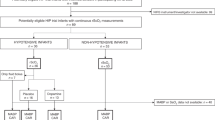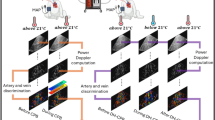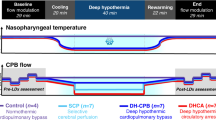Abstract
Perinatal distress in the preterm neonate, and the consequent loss of cerebrovascular autoregulation, has been implicated in the pathogenesis of neonatal cerebral lesions. A component of this distress is thought to be hypotension. We examined the autoregulatory capacity of hypotensive and normotensive infants using the 133Xe technique to measure cerebral blood flow. Global CBF was measured during only normotension in 5 infants, and during both hypotension and normotension in 11 infants. All the infants were ventilated and blood pressure was measured using an intra-arterial catheter. Fourteen CBF measurements were made on the normotensive infants. Forty-seven CBF measurements were made on the hypotensive infants, 34 measurements during hypotension and 13 during normotension. The global CBF of the normotensive and hypotensive infants were 13.3 and 13.6 mL/100 g/min, respectively. The mean arterial blood pressure (MABP)-CBF reactivity (95% CI) of the normotensive and hypotensive infants were 1.9% (−0.8% to 4.7%)/mm Hg and 1.9% (0.8% to 3.0%)/mm Hg, respectively. The CO2-CBF reactivity (95%CI) of the normotensive and hypotensive infants was 11.1% (6.8% to 15.5%)/KPa ΔPaCO2 and 4.1% (−5.0% to 14.1%)/KPa ΔPaCO2. The implications of these calculated CBF reactivities is that normotensive infants may have intact autoregulation but with a diminished response to fluctuations in PaCO2. The hypotensive infants appear to have attenuated or absent autoregulation with little or no response in CBF to changes in PaCO2.
Similar content being viewed by others
Log in or create a free account to read this content
Gain free access to this article, as well as selected content from this journal and more on nature.com
or
Abbreviations
- CBF:
-
global cerebral blood flow
- CBFv:
-
cerebral blood flow velocity
- MABP:
-
mean arterial blood pressure
- MAP15:
-
MABP averaged over 15 min
- PaCO2:
-
partial pressure of carbon dioxide
- PDA:
-
patent ductus arteriosus
- VLBW:
-
very low birthweight
- 95%:
-
CI 95% confidence interval
- 133Xe:
-
133Xenon radionuclide
REFERENCES
Szymonowicz W, Yu VY, Wilson FE 1984 Antecedents of periventricular haemorrhage in infants weighing 1250 g or less at birth. Arch Dis Child 59: 13–17
Trounce JQ, Shaw DE, Levene MI, Rutter N 1988 Clinical risk factors and periventricular leucomalacia. Arch Dis Child 63: 17–22
Nowicki PT, Nankervis CA 1994 The role of the circulation in the pathogenesis of necrotizing enterocolitis. Clin Perinatol 21: 219–234
Low JA, Froese AB, Smith JT, Galbraith RS, Sauerbrei EE, Karchmar EJ 1992 Hypotension and hypoxemia in the preterm newborn during the four days following delivery identify infants at risk of echosonographically demonstrable cerebral lesions. Clin Invest Med 15: 60–65
Lou HC, Lassen NA, Friis-Hansen B 1977 Low cerebral blood flow in hypotensive perinatal distress. Acta Neurol Scand 56: 343–352
Wigglesworth JS, Pape KE 1978 An integrated model for haemorrhagic and ischaemic lesions in the newborn brain. Early Hum Dev 2: 179–199
Tyszczuk L, Meek J, Elwell C, Wyatt JS 1998 Cerebral blood flow is independent of mean arterial blood pressure in preterm infants undergoing intensive care. Pediatrics 102: 337–341
Perlman JM, Risser R, Broyles RS 1996 Bilateral cystic periventricular leukomalacia in the premature infant: associated risk factors. Pediatrics 97: 822–827
Weindling AM, Wilkinson AR, Cook J, Calvert SA, Fok TF, Rochefort MJ 1985 Perinatal events which precede periventricular haemorrhage and leukomalacia in the newborn. Br J Obstet Gynaecol 92: 1218–1223
Tsuji M, Saul JP, du Plessis A, Eichenwald E, Sobh J, Crocker R, Volpe JJ 2000 Cerebral intravascular oxygenation correlates with mean arterial pressure in critically ill premature infants. Pediatrics 106: 625–632
Boylan GB, Young K, Panerai RB, Rennie JM, Evans DH 2000 Dynamic cerebral autoregulation in sick newborn infants. Pediatr Res 48: 12–17
Pryds O, Greisen G 1989 Effect of PaCO2 and haemoglobin concentration on day to day variation of CBF in preterm neonates. Acta Paediatr Scand Suppl 360: 33–36
Pryds O, Greisen G, Lou H, Friis-Hansen B 1989 Heterogeneity of cerebral vasoreactivity in preterm infants supported by mechanical ventilation. J Pediatr 115: 638–645
Blomstrand S, Karlsson K, Kjellmer I 1978 Measurement of cerebral blood flow in the fetal lamb with a note on the flow-distribution. Acta Physiol Scand 103: 1–8
Purves MJ, James IM 1969 Observations on the control of cerebral blood flow in the sheep fetus and newborn lamb. Circ Res 25: 651–667
Greisen G, Johansen K, Ellison PH, Fredriksen PS, Mali J, Friis-Hansen B 1984 Cerebral blood flow in the newborn infant: comparison of Doppler ultrasound and 133xenon clearance. J Pediatr 104: 411–418
Skov L, Pryds O, Greisen G 1991 Estimating cerebral blood flow in newborn infants: comparison of near infrared spectroscopy and 133Xe clearance. Pediatr Res 30: 570–573
Watkins AM, West CR, Cooke RW 1989 Blood pressure and cerebral haemorrhage and ischaemia in very low birthweight infants. Early Hum Dev 19: 103–110
Greisen G, Trojaborg W 1987 Cerebral blood flow, PaCO2 changes, and visual evoked potentials in mechanically ventilated, preterm infants. Acta Paediatr Scand 76: 394–400
Kleinbaum DG 1998 Applied regression analysis and other multivariable methods. Duxbury Press, Pacific Grove London
Lassen NA 1978 Study of local cerebral blood flow. In: Dickinson CJ, Marks J (eds) Developments in Cardiovascular Medicine: The Proceedings of the Special Symposium. MTP Press, Lancaster, pp 9–14.
Heistad DD, Kontos HA 1983 Cerebran circulation. In: Sheperd JT, Abboud FM (eds) Peripheral Circulation and Organ Blood Flow Volume. American Physiological Society, Bethesda, pp III:137–182
Baenziger O, Jaggi JL, Mueller AC, Morales CG, Lipp AE, Duc G, Bucher HU 1995 Regional differences of cerebral blood flow in the preterm infant. Eur J Pediatr 154: 919–924
Pryds O, Greisen G, Skov LL, Friis-Hansen B 1990 Carbon dioxide-related changes in cerebral blood volume and cerebral blood flow in mechanically ventilated preterm neonates: comparison of near infrared spectrophotometry and 133Xenon clearance. Pediatr Res 27: 445–449
Smith EO 1987 Analysis of repeated measures designs. J Pediatr 111: 723–725
Anthony MY, Evans DH, Levene MI 1993 Neonatal cerebral blood flow velocity responses to changes in posture. Arch Dis Child 69: 304–308
Jorch G, Jorch N 1987 Failure of autoregulation of cerebral blood flow in neonates studied by pulsed Doppler ultrasound of the internal carotid artery. Eur J Pediatr 146: 468–472
Menke J, Michel E, Rabe H, Bresser BW, Grohs B, Schmitt RM, Jorch G 1993 Simultaneous influence of blood pressure, PCO2, and PO2 on cerebral blood flow velocity in preterm infants of less than 33 weeks' gestation. Pediatr Res 34: 173–177
Panerai RB, Kelsall AW, Rennie JM, Evans DH 1995 Estimation of critical closing pressure in the cerebral circulation of newborns. Neuropediatrics 26: 168–173
Thoresen M, Whitelaw A 1990 Effect of acetazolamide on cerebral blood flow velocity and CO2 elimination in normotensive and hypotensive newborn piglets. Biol Neonate 58: 200–207
Faraci FM, Heistad DD 1990 Regulation of large cerebral arteries and cerebral microvascular pressure. Circ Res 66: 8–17
Levene MI, Shortland D, Gibson N, Evans DH 1988 Carbon dioxide reactivity of the cerebral circulation in extremely premature infants: effects of postnatal age and indomethacin. Pediatr Res 24: 175–179
Fenton AC, Woods KL, Evans DH, Levene MI 1992 Cerebrovascular carbon dioxide reactivity and failure of autoregulation in preterm infants. Arch Dis Child 67: 835–839
Wyatt JS, Edwards AD, Cope M, Delpy DT, McCormick DC, Potter A, Reynolds EO 1991 Response of cerebral blood volume to changes in arterial carbon dioxide tension in preterm and term infants. Pediatr Res 29: 553–557
Whitelaw A, Karlsson BR, Haaland K, Dahlin I, Steen PA, Thoresen M 1991 Hypocapnia and cerebral ischaemia in hypotensive newborn piglets. Arch Dis Child 66: 1110–1114
Panerai RB 1998 Assessment of cerebral pressure autoregulation in humans–a review of measurement methods. Physiol Meas 19: 305–338
Lee J, Rajadurai VS, Tan KW 1999 Blood pressure standards for very low birthweight infants during the first day of life. Arch Dis Child Fetal Neonatal Ed 81: F168–170
Cunningham S, Symon AG, Elton RA, Zhu C, McIntosh N 1999 Intra-arterial blood pressure reference ranges, death and morbidity in very low birthweight infants during the first seven days of life. Early Hum Dev 56: 151–165
Versmold HT, Kitterman JA, Phibbs RH, Gregory GA, Tooley WH 1981 Aortic blood pressure during the first 12 hours of life in infants with birth weight 610 to 4,220 grams. Pediatrics 67: 607–613
1992 Development of audit measures and guidelines for good practice in the management of neonatal respiratory distress syndrome. Report of a Joint Working Group of the British Association of Perinatal Medicine and the Research Unit of the Royal College of Physicians. Arch Dis Child 67: 1221–1227
Pryds O, Greisen G, Friis-Hansen B 1988 Compensatory increase of CBF in preterm infants during hypoglycaemia. Acta Paediatr Scand 77: 632–637
Colditz PB, Williams GL, Berry AB, Symonds PJ 1989 Variability of Doppler flow velocity and cerebral perfusion pressure is reduced in the neonate by sedation and neuromuscular blockade. Aust Paediatr J 25: 171–173
Weir FJ, Ohlsson A, Myhr TL, Fong K, Ryan ML 1999 A patent ductus arteriosus is associated with reduced middle cerebral artery blood flow velocity. Eur J Pediatr 158: 484–487
Kluckow M, Evans N 2000 Low superior vena cava flow and intraventricular haemorrhage in preterm infants. Arch Dis Child Fetal Neonatal Ed 82: F188–194
Kurtis PS, Rosenkrantz TS, Zalneraitis EL 1995 Cerebral blood flow and EEG changes in preterm infants with patent ductus arteriosus. Pediatr Neurol 12: 114–119
Miall-Allen VM, de Vries LS, Whitelaw AG 1987 Mean arterial blood pressure and neonatal cerebral lesions. Arch Dis Child 62: 1068–1069
Acknowledgements
We would like to thank the Special Trustees of the General Infirmary at Leeds for funding the study and Professor Gorm Greisen for helpful advice during the course of the study.
Author information
Authors and Affiliations
Corresponding author
Rights and permissions
About this article
Cite this article
Jayasinghe, D., Gill, A. & Levene, M. CBF Reactivity in Hypotensive and Normotensive Preterm Infants. Pediatr Res 54, 848–853 (2003). https://doi.org/10.1203/01.PDR.0000088071.30873.DA
Received:
Accepted:
Issue date:
DOI: https://doi.org/10.1203/01.PDR.0000088071.30873.DA
This article is cited by
-
Near-infrared spectroscopy monitoring of neonatal cerebrovascular reactivity: where are we now?
Pediatric Research (2023)
-
The association between carbon dioxide, cerebral blood flow, and autoregulation in the premature infant
Journal of Perinatology (2021)
-
Relationship between systemic blood flow, blood pressure, inotropes, and aEEG in the first 48 h of life in extremely preterm infants
Pediatric Research (2013)
-
Observational study of cerebral hemodynamics during dopamine treatment in hypotensive ELBW infants on the first day of life
Journal of Perinatology (2013)
-
Cerebral blood flow velocity in early-onset neonatal sepsis and its clinical significance
European Journal of Pediatrics (2012)



